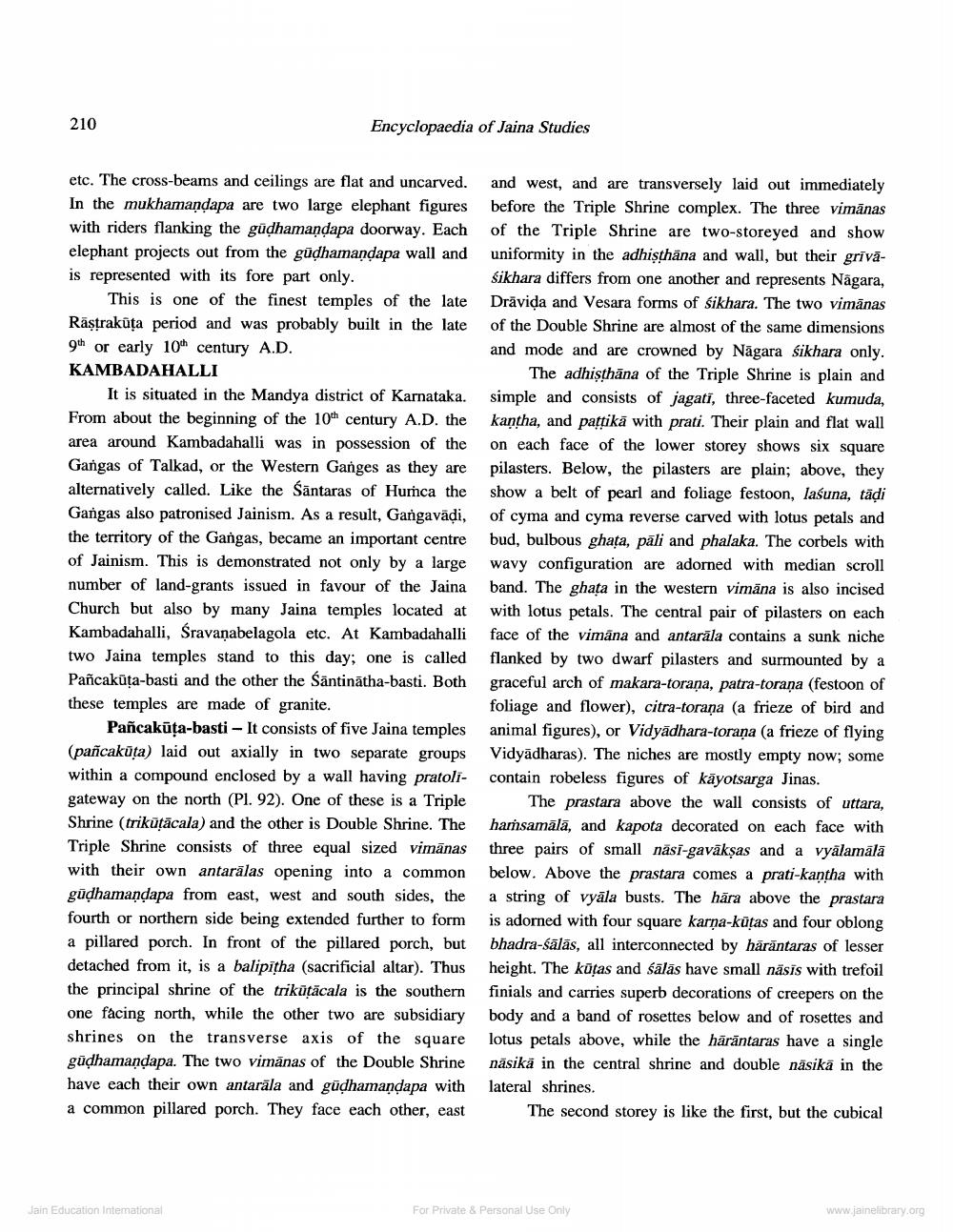________________
210
Encyclopaedia of Jaina Studies
etc. The cross-beams and ceilings are flat and uncarved. In the mukhamandapa are two large elephant figures with riders flanking the gudhamandapa doorway. Each elephant projects out from the gūdhamandapa wall and is represented with its fore part only.
This is one of the finest temples of the late Rāştrakūta period and was probably built in the late 9th or early 10th century A.D. KAMBADAHALLI
It is situated in the Mandya district of Karnataka. From about the beginning of the 100 century A.D. the area around Kambadahalli was in possession of the Gangas of Talkad, or the Western Ganges as they are alternatively called. Like the sāntaras of Humca the Gangas also patronised Jainism. As a result, Gangavādi, the territory of the Gangas, became an important centre of Jainism. This is demonstrated not only by a large number of land-grants issued in favour of the Jaina Church but also by many Jaina temples located at Kambadahalli, Sravanabelagola etc. At Kambadahalli two Jaina temples stand to this day; one is called Pancaküta-basti and the other the Säntinātha-basti. Both these temples are made of granite.
Pañcakūta-basti - It consists of five Jaina temples (pañcakūta) laid out axially in two separate groups within a compound enclosed by a wall having pratoli- gateway on the north (Pl. 92). One of these is a Triple Shrine (trikūtācala) and the other is Double Shrine. The Triple Shrine consists of three equal sized vimānas with their own antarälas opening into a common gūdhamandapa from east, west and south sides, the fourth or northern side being extended further to form a pillared porch. In front of the pillared porch, but detached from it, is a balipītha (sacrificial altar). Thus the principal shrine of the trikūtācala is the southern one facing north, while the other two are subsidiary shrines on the transverse axis of the square gūdhamandapa. The two vimānas of the Double Shrine have each their own antarala and gūdhamandapa with a common pillared porch. They face each other, east
and west, and are transversely laid out immediately before the Triple Shrine complex. The three vimānas of the Triple Shrine are two-storeyed and show uniformity in the adhisthāna and wall, but their grīvāSikhara differs from one another and represents Nägara, Drāvida and Vesara forms of sikhara. The two vimānas of the Double Shrine are almost of the same dimensions and mode and are crowned by Nāgara sikhara only.
The adhisthāna of the Triple Shrine is plain and simple and consists of jagati, three-faceted kumuda, kantha, and pattikā with prati. Their plain and flat wall on each face of the lower storey shows six square pilasters. Below, the pilasters are plain; above, they show a belt of pearl and foliage festoon, lasuna, tādi of cyma and cyma reverse carved with lotus petals and bud, bulbous ghata, pāli and phalaka. The corbels with wavy configuration are adorned with median scroll band. The ghata in the western vimāna is also incised with lotus petals. The central pair of pilasters on each face of the vimāna and antarala contains a sunk niche flanked by two dwarf pilasters and surmounted by a graceful arch of makara-torana, patra-torana (festoon of foliage and flower), citra-toraņa (a frieze of bird and animal figures), or Vidyadhara-torana (a frieze of flying Vidyadharas). The niches are mostly empty now; some contain robeless figures of kāyotsarga Jinas.
The prastara above the wall consists of uttara, haṁsamālā, and kapota decorated on each face with three pairs of small näsi-gavākṣas and a vyālamālā below. Above the prastara comes a prati-kantha with a string of vyāla busts. The hāra above the prastara is adorned with four square karna-kütas and four oblong bhadra-śālās, all interconnected by hárāntaras of lesser height. The kūtas and śālās have small nāsis with trefoil finials and carries superb decorations of creepers on the body and a band of rosettes below and of rosettes and lotus petals above, while the hārāntaras have a single näsikä in the central shrine and double näsika in the lateral shrines.
The second storey is like the first, but the cubical
Jain Education International
For Private & Personal Use Only
www.jainelibrary.org




